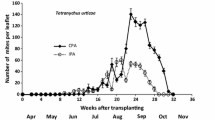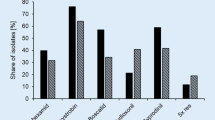Abstract
Tetranychus urticae Koch (Acari: Tetranychidae), twospotted spider mite, is a major secondary pest of strawberry and can cause significant yield loss. Tetranychus urticae is typically controlled using miticides, which has led to rapid resistance development. In South Carolina (USA), extension agents and growers have reported field failures of miticides (inadequate pest suppression), but resistance has not been quantitatively determined. In 2018, we determined the level of miticide resistance of six T. urticae populations found on strawberry across South Carolina. We examined efficacy of all miticides registered for use on US strawberry by conducting an initial diagnostic bioassay at 20% of the maximum labeled field rate. Any population × active ingredient combination resulting in < 55% mortality was identified as ‘potentially resistant’ and concentration–response bioassays were then conducted to calculate LC50 values for an individual population. These values were compared with those of a known-susceptible laboratory population to calculate resistance ratios (RR). Our results indicate that examined South Carolina populations of T. urticae from strawberry were highly resistant to bifenthrin (RR = 100–60,000) and there was reduced susceptibility to fenbutatin-oxide (RR = 25–123). The 'Sardinia' population had decreased abamectin susceptibility (RR = 25). No resistance to hexythiazox, etoxazole, acequinocyl, bifenazate, fenpyroximate, spiromesifen, or cyflumetofen was found. Based on available data, it appears that miticide resistance is not a likely cause of field failures and issues related to application error and coverage should be investigated. Overall, this work supports the need to reduce the use of broad-spectrum pesticides and older products, in favor of newer miticide chemistries due to resistance issues.
Similar content being viewed by others
Data availability
Data and materials associated with this experiment are available upon request.
Code availability
Code associated with this experiment is available upon request.
References
Adesanya AW, Franco E, Walsh DB, Lavine M, Lavine L, Zhu F (2018) Phenotypic and genotypic plasticity of acaricide resistance in populations of Tetranychus urticae (Acari: Tetranychidae) on peppermint and silage corn in the Pacific Northwest. J Econ Entomol 111(6):2831–2843
Bergeron PE, Schmidt-Jeffris RA (2020) Not all predators are equal: miticide non-target effects and differential selectivity. Pest Manag Sci 76:2170–2179
Braekman P, Foque D, Messens W, Van Labeke MC, Pieters JG, Nuyttens D (2010) Effect of spray application technique on spray deposition in greenhouse strawberries and tomatoes. Pest Manag Sci 66:203–212
Bruck DJ, Bolda M, Tanigoshi L, Klick J, Kleiber J, DeFrancesco J, Gerdeman B, Spitler H (2011) Laboratory and field comparisons of insecticides to reduce infestation of Drosophila suzukii in berry crops. Pest Manag Sci 67:1375–1385
Chatterjee M, Bermudez-Lozano CL, Clancy MA, Davis TM, Folta KM (2011) A strawberry KNOX gene regulates leaf, flower and meristem architecture. PLoS ONE 6:e24752
Cheng S, Lin R, Zhang N, Yuan S, Zhou X, Huang J, Ren X, Wang S, Jiang H, Yu C (2018) Toxicity of six insecticides to predatory mite Amblyseius cucumeris (Oudemans) (Acari: Phytoseiidae) in- and off-field. Ecotoxicol Environ Saf 161:715–720
Croft BA (1990) Pesticide selectivity: pyrethroids. Arthropod biological control agents and pesticides. Wiley, New York, pp 335–353
Darnell R (2003) The Strawberry. a book for growers, others. In: Childers NF (ed), Norman F. Childers Publications, Gainesville
Dermauw W, Wybouw N, Rombauts S, Menten B, Vontas J, Grbić M, Clark RM, Feyereisen R, Van Leeuwen T (2013) A link between host plant adaptation and pesticide resistance in the polyphagous spider mite Tetranychus urticae. Proc Natl Acad Sci USA 110:E113–E122
Gan-Mor S, Grinstein A, Beres H, Riven Y, Zur I (1996) Improved uniformity of spray deposition in a dense plant canopy: methods and equipment. Phytoparasitica 24:57–67
Gimenez-Ferrer RM, Erb AW, Bishop BL, Scheerens JC (1994) Host-pest relationships between the twospotted spider mite (Acari: Tetranychidae) and strawberry cultivars with differing levels of resistance. J Econ Entomol 87:168–175
Ilias A, Vontas J, Tsagkarakou A (2014) Global distribution and origin of target site insecticide resistance mutations in Tetranychus urticae. Insect Biochem Mol Biol 48:17–28
Ilias A, Vassiliou VA, Vontas J, Tsagkarakou A (2017) Molecular diagnostics for detecting pyrethroid and abamectin resistance mutations in Tetranychus urticae. Pestic Biochem Physiol 135:9–14
İnak E, Alpkent YN, Çobanoğlu S, Dermauw W, Van Leeuwen T (2019) Resistance incidence and presence of resistance mutations in populations of Tetranychus urticae from vegetable crops in Turkey. Exp Appl Acarol 78(3):343–360
Kavousi A, Talebi K (2003) Side-effects of three pesticides on the predatory mite, Phytoseiulus persimilis (Acari: Phytoseiidae). Exp Appl Acarol 31:51–58
Khajehali J, Van Nieuwenhuyse P, Demaeght P, Tirry L, Van Leeuwen T (2011) Acaricide resistance and resistance mechanisms in Tetranychus urticae populations from rose greenhouses in the Netherlands. Pest Manag Sci 67(11):1424–1433
Kwon DH, Clark JM, Lee SH (2010) Cloning of a sodium channel gene and identification of mutations putatively associated with fenpropathrin resistance in Tetranychus urticae. Pestic Biochem Physiol 97(2):93–100
Lefebvre M, Bostanian NJ, Mauffette Y, Racette G, Thistlewood HA, Hardman JM (2012) Laboratory-based toxicological assessments of new insecticides on mortality and fecundity of Neoseiulus fallacis (Acari: Phytoseiidae). J Econ Entomol 105:866–871
Lümmen P, Khajehali J, Luther K, Van Leeuwen T (2014) The cyclic keto-enol insecticide spirotetramat inhibits insect and spider mite acetyl-CoA carboxylases by interfering with the carboxyltransferase partial reaction. Insect Biochem Mol Biol 55:1–8
Manor G, Hofner A, Or R, Phishler G, Epstein Y, Nakash T, Jacobi M (1989) Air stream facilitated application of cotton foliage treatments. Trans ASAE 32:37–0038
Marcic D (2012) Acaricides in modern management of plant-feeding mites. J Pest Sci 85:395–408
McMurtry J, Huffaker C, Van de Vrie M (1970) Ecology of tetranychid mites and their natural enemies: a review: I. tetranychid enemies: their biological characters and the impact of spray practices. Hilgardia 40:331–390
Melanson RA, Johnson C, Schnabel G, Ferguson MH, Desaeger J, Burrack HJ, Pfeiffer D, Sial A, Hale F, Jennings K, Brannen P (2020) 2020 Southeast regional strawberry integrated pest management guide for plasticulture production. https://smallfruits.org/files/2020/02/2020-Strawberry-IPM-Guide.pdf. Accessed 25 Aug 2020
Migeon A, Dorkeld F (2019) Spider Mites Web: a comprehensive database for the Tetranychidae. http://www1.montpellier.inra.fr/CBGP/spmweb/index.php. Accessed 25 Aug 2020
Mota-Sanchez D, Wise J (2020) Arthropod pesticide resistance database. Michigan State University. http://www.pesticideresistance.org. Accessed 25 Aug 2020
Nauen R, Wölfel K, Lueke B, Myridakis A, Tsakireli D, Roditakis E, Tsagkarakou A, Stephanou E, Vontas J (2015) Development of a lateral flow test to detect metabolic resistance in Bemisia tabaci mediated by CYP6CM1, a cytochrome P450 with broad spectrum catalytic efficiency. Pestic Biochem Physiol 121:3–11
Nordmark L (1993) Spray technology for improving the deposition in field vegetables and strawberries. In: Symposium on Engineering as a Tool to reduce Pesticide Consumption and Operator Hazards in Horticulture 372, pp. 103–110
Nyoike TW, Liburd OE (2013) Effect of Tetranychus urticae (Acari: Tetranychidae), on marketable yields of field-grown strawberries in north-central Florida. J Econ Entomol 106:1757–1766
Ozkan HE, Derksen RC (1998) Effectiveness of turbodrop and turbo teejet nozzles in drift reduction. Extension Fact Sheet AEX. pp. 524–598.
Piraneo TG, Bull J, Morales MA, Lavine LC, Walsh DB, Zhu F (2015) Molecular mechanisms of Tetranychus urticae chemical adaptation in hop fields. Sci Rep 5(1):1–12
Ramsdale BK, Messersmith CG (2001) Drift-reducing nozzle effects on herbicide performance. Weed Technol 15:453–460
Renkema J, Dubon F, Peres N, Evans B (2020) Twospotted spider mites (Tetranychus urticae) on strawberry (Fragaria × ananassa) transplants, and the potential to eliminate them with steam treatment. Int J Fruit Sci 20:978–991
Savini G, Neri D (2003) Strawberry architectural model. In: Euro Berry Symposium-COST-Action 836 Final Workshop 649, 2003. pp. 169–176
Savini G, Neri D, Zucconi F, Sugiyama N (2005) Strawberry growth and flowering: an architectural model. Int J Fruit Sci 5:29–50
Schmidt-Jeffris R, Snipes Z, Bergeron P (2021) Acaricide efficacy and resistance in South Carolina tomato populations of twospotted spider mite. Florida Entomologist. (in press)
Sharpe SM, Boyd NS, Dittmar PJ, MacDonald GE, Darnell RL, Ferrell JA (2018) Spray penetration into a strawberry canopy as affected by canopy structure, nozzle type, and application volume. Weed Technol 32:80–84
Sumner HR, Herzog GA (2000) Assessing the effectiveness of air-assisted and hydraulic sprayers in cotton via leaf bioassay. J Cotton Sci 4:79–83
Tian T, Grafton-Cardwell EE, Granett J (1992) Resistance of Tetranychus urticae Koch (Acari: Tetranychidae) to cyhexatin and fenbutatin-oxide in California Pears. J Econ Entomol 85(6):2088–2095
Tsagkarakou A, Van Leeuwen T, Khajehali J, Ilias A, Grispou M, Williamson MS, Tirry L, Vontas J (2009) Identification of pyrethroid resistance associated mutations in the para sodium channel of the two-spotted spider mite Tetranychus urticae (Acari: Tetranychidae). Insect Mol Biol 18(5):583–593
Van Leeuwen T, Van Pottelberge S, Tirry L (2005) Comparative acaricide susceptibility and detoxifying enzyme activities in field-collected resistant and susceptible strains of Tetranychus urticae. Pest Manag Sci 61:499–507
Van Leeuwen T, Vontas J, Tsagkarakou A, Dermauw W, Tirry L (2010) Acaricide resistance mechanisms in the two-spotted spider mite Tetranychus urticae and other important Acari: a review. Insect Biochem Mol Biol 40:563–572
Van Leeuwen T, Tirry L, Yamamoto A, Nauen R, Dermauw W (2015) The economic importance of acaricides in the control of phytophagous mites and an update on recent acaricide mode of action research. Pestic Biochem Physiol 121:12–21
Van Leeuwen T, Dermauw W, Mavridis K, Vontas J (2020) Significance and interpretation of molecular diagnostics for insecticide resistance management of agricultural pests. Curr Opin Insect Sci 39:69–76
Villanueva RT, Walgenbach JF (2005) Development, oviposition, and mortality of Neoseiulus fallacis (Acari: Phytoseiidae) in response to reduced-risk insecticides. J Econ Entomol 98:2114–2120
Wolf RE (2000) Equipment to reduce spray drift. Kansas State University Agricultural Experiment Station and Cooperative Extension Service Publication# MF-2445. pp. 1–4.
Wu M, Adesanya AW, Morales MA, Walsh DB, Lavine LC, Lavine MD, Zhu F (2019) Multiple acaricide resistance and underlying mechanisms in Tetranychus urticae on hops. J Pest Sci 92(2):543–555
Xiao J, Chen L, Pan F, Deng Y, Ding C, Liao M, Su X, Cao H (2020) Application method affects pesticide efficiency and effectiveness in wheat fields. Pest Manag Sci 76:1256–1264
Xu D, He Y, Zhang Y, Xie W, Wu Q, Wang S (2018) Status of pesticide resistance and associated mutations in the two-spotted spider mite, Tetranychus urticae, in China. Pestic Biochem Physiol 150:89–96
Xue W, Snoeck S, Njiru C, Inak E, Dermauw W, Van Leeuwen T (2020) Geographical distribution and molecular insights into abamectin and milbemectin cross-resistance in European field populations of Tetranychus urticae. Pest Manag Sci 76(8):2569–2581
Yang X, Margolies DC, Zhu KY, Buschman LL (2001) Host plant-induced changes in detoxification enzymes and susceptibility to pesticides in the twospotted spider mite (Acari: Tetranychidae). J Econ Entomol 94:381–387
Yarpuz-Bozdogan N, Atakan E, Bozdogan AM, Yilmaz H, Daglioglu N, Erdem T, Kafkas E (2011) Effect of different pesticide application methods on spray deposits, residues and biological efficacy on strawberries. Afr J Agric Res 6:660–670
Acknowledgements
The authors thank M. Farfan, D. Lewis, J. Coffey, K. Dennis, S. Ellis, D. Madden, and G. Sinclair for technical assistance. They also thank Drs. Sriyanka Lahiri and Wee Yee for comments on an earlier draft of this manuscript. The use of trade, firm, or corporation names in this publication is for the information and convenience of the reader. Such use does not constitute an official endorsement or approval by the United States Department of Agriculture or the Agricultural Research Service of any product or service to the exclusion of others that may be suitable.
Funding
This project was supported by the Southern Region Small Fruit Consortium and through industry gifts of pesticide.
Author information
Authors and Affiliations
Contributions
PEB conducted the experiments, wrote the manuscript, and led manuscript editing. RSJ designed the experiments, assisted with manuscript writing, and contributed to manuscript editing.
Corresponding author
Additional information
Publisher's Note
Springer Nature remains neutral with regard to jurisdictional claims in published maps and institutional affiliations.
Rights and permissions
About this article
Cite this article
Bergeron, P.E., Schmidt-Jeffris, R.A. Spider mite resistance to miticides in South Carolina strawberry and implications for improved integrated pest management. Exp Appl Acarol 84, 407–418 (2021). https://doi.org/10.1007/s10493-021-00621-7
Received:
Accepted:
Published:
Issue Date:
DOI: https://doi.org/10.1007/s10493-021-00621-7




